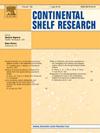恒河海底三角洲表层沉积物的粘土矿物成分和迁移模式
IF 2.1
3区 地球科学
Q2 OCEANOGRAPHY
引用次数: 0
摘要
恒河海底三角洲是印度洋东北部一个重要的陆海过渡区。了解该地区沉积物的分布、来源和迁移情况,对于了解其沉积环境和印度洋东北部的沉积物 "源-汇 "系统具有重要意义。本研究旨在通过分析 84 个表层沉积物样本的粒度和粘土矿物含量,确定恒河海底三角洲细粒沉积物的来源和迁移模式。沉积物中伊利石、绿泥石、高岭石和直闪石的含量分别为 66%、18%、11% 和 5%。沉积物伊利石含量由北向南递减;叶腊石和绿泥石含量分别由西北向东南递减和递增;高岭石含量以南部最高。通过对四种粘土矿物的空间聚类分析,将研究区域划分为两个区域:北部的 I 区具有与恒河-布拉马普特拉河粘土矿物组合相似的特征;南部的 II 区具有深水特征,由于来自印度半岛的物质混合,粘土矿物特征发生了变化。本研究采用伊利石/(直闪石+绿泥石+高岭石)和高岭石/伊利石比率来讨论这两个省份的沉积物运移路径。喜马拉雅物质广泛分布于整个研究区域,主要受潮汐、羽流和季风的影响从河口向西南地区迁移;马哈纳迪河的沉积物受西南季风的影响从西南向东北迁移,从而影响了第二省的沉积物组成。本文章由计算机程序翻译,如有差异,请以英文原文为准。
Clay mineral composition and transport pattern of surface sediments in the Ganges Submarine Delta
The Ganges Submarine Delta is a key land-sea transitional area in the northeastern Indian Ocean. An understanding of sediment distribution, provenance, and transportation in this area is of great importance for understanding its sedimentary environment and the sediment “source-sink” system of the northeastern Indian Ocean. This study aimed to identify the provenances and transport patterns of fine-grained sediments in the Ganges Submarine Delta through analysis of the grain size and clay mineral content of 84 surface sediment samples. Sediment illite, chlorite, kaolinite, and smectite contents were ∼66%, 18%, 11%, and 5%, respectively. Sediment illite content decreased from north to south; smectite and chlorite decreased and increased from northwest to southeast, respectively; kaolinite content was highest in the south. Spatial cluster analysis of the four clay minerals grouped the study area into two provinces: province I in the north is characterized by a clay mineral assemblage similar to that of the Ganges-Brahmaputra rivers; province II in the south is characterized by deep water and changes to clay mineral characteristics due to the mixing of material originating from the Indian Peninsula. This study used the illite/(smectite + chlorite + kaolinite) and kaolinite/illite ratios to discuss sediment transport paths in the two provinces. Himalayan material is widely distributed throughout the study area, and mainly transported from the estuary to the southwestern area by the tides, plume, and monsoons; sediments of the Mahanadi river are transported from southwest to northeast by the southwest monsoon, thereby affecting the sediment composition of province II.
求助全文
通过发布文献求助,成功后即可免费获取论文全文。
去求助
来源期刊

Continental Shelf Research
地学-海洋学
CiteScore
4.30
自引率
4.30%
发文量
136
审稿时长
6.1 months
期刊介绍:
Continental Shelf Research publishes articles dealing with the biological, chemical, geological and physical oceanography of the shallow marine environment, from coastal and estuarine waters out to the shelf break. The continental shelf is a critical environment within the land-ocean continuum, and many processes, functions and problems in the continental shelf are driven by terrestrial inputs transported through the rivers and estuaries to the coastal and continental shelf areas. Manuscripts that deal with these topics must make a clear link to the continental shelf. Examples of research areas include:
Physical sedimentology and geomorphology
Geochemistry of the coastal ocean (inorganic and organic)
Marine environment and anthropogenic effects
Interaction of physical dynamics with natural and manmade shoreline features
Benthic, phytoplankton and zooplankton ecology
Coastal water and sediment quality, and ecosystem health
Benthic-pelagic coupling (physical and biogeochemical)
Interactions between physical dynamics (waves, currents, mixing, etc.) and biogeochemical cycles
Estuarine, coastal and shelf sea modelling and process studies.
 求助内容:
求助内容: 应助结果提醒方式:
应助结果提醒方式:


